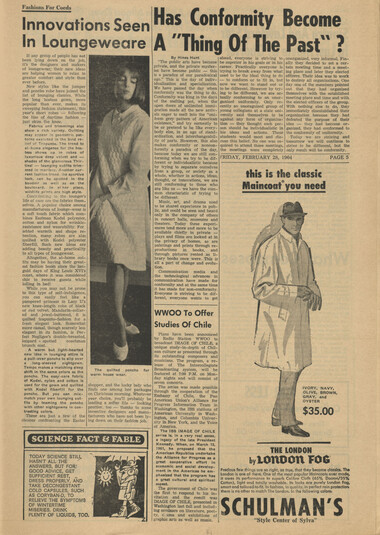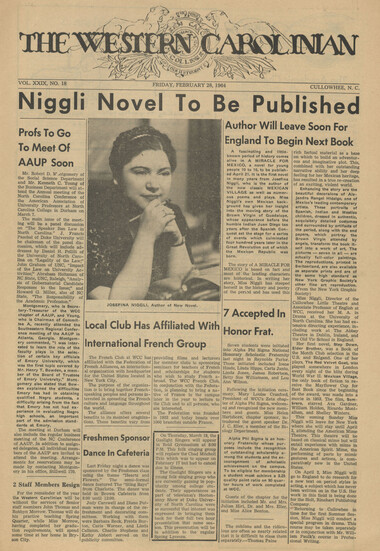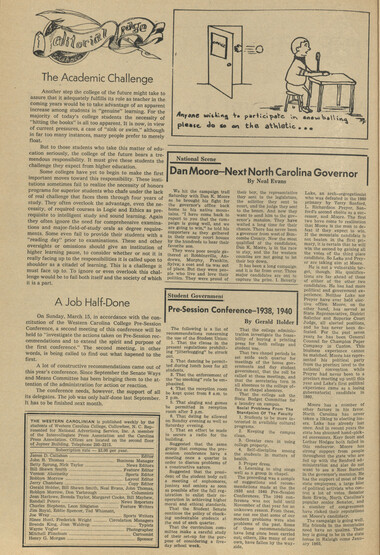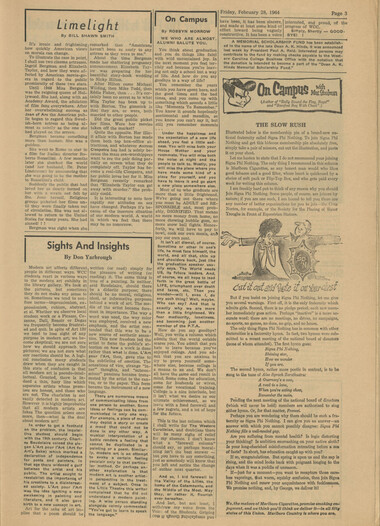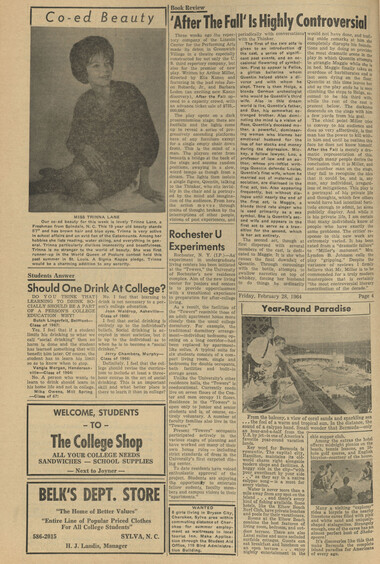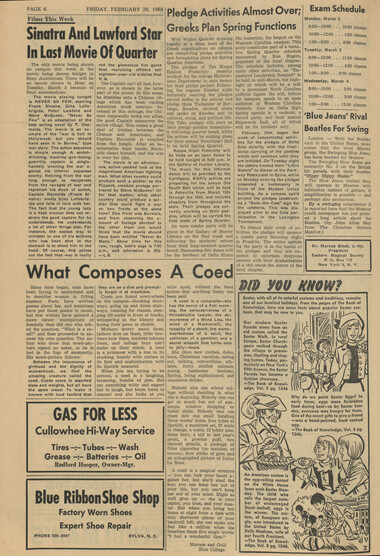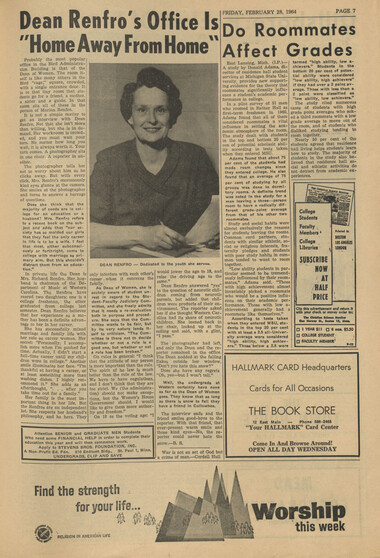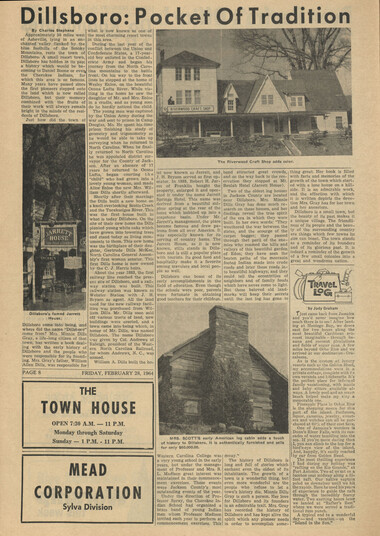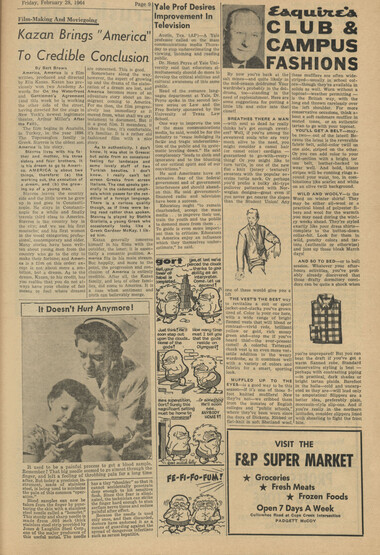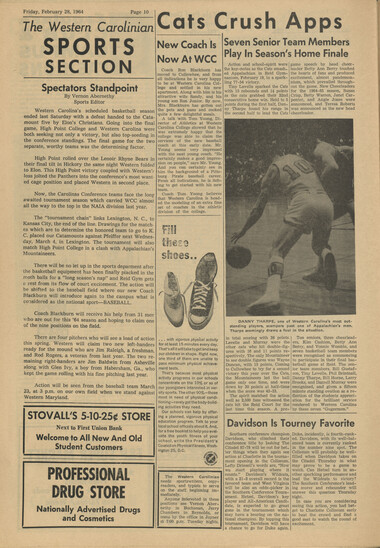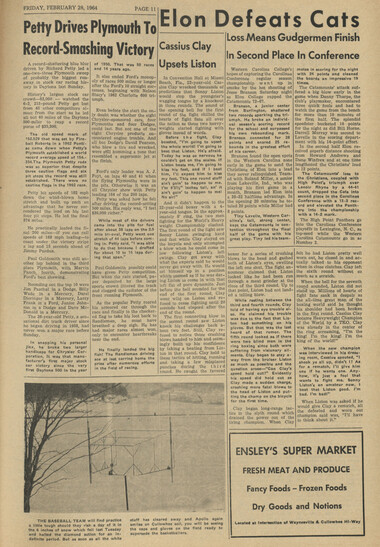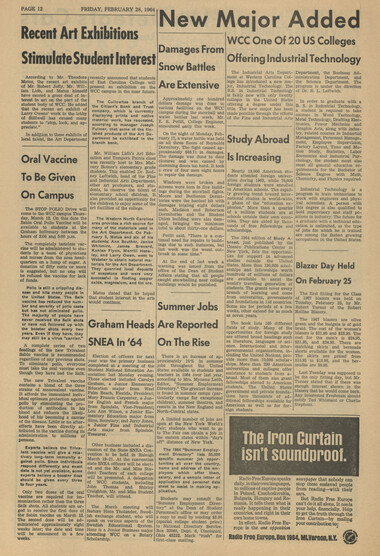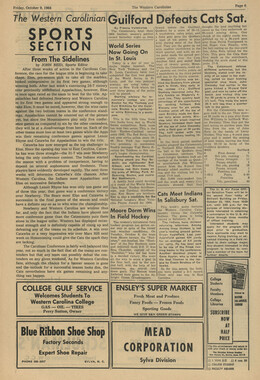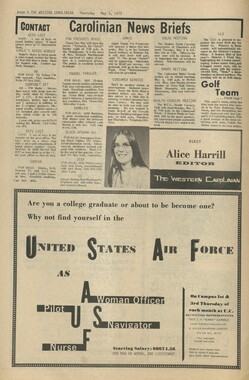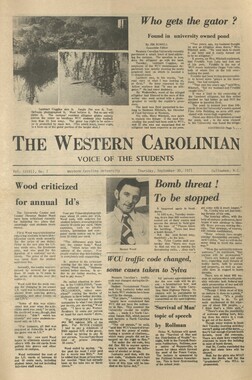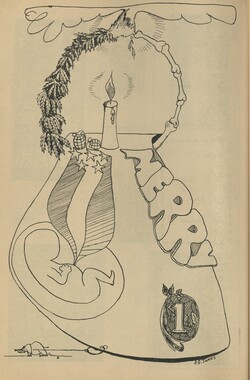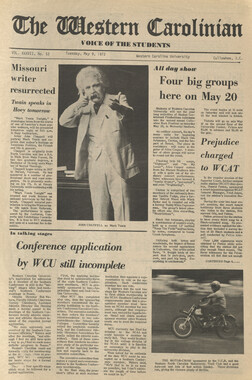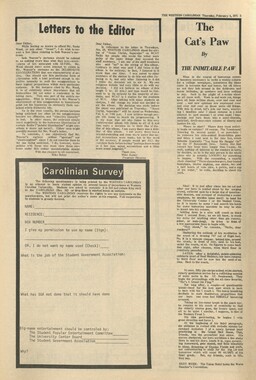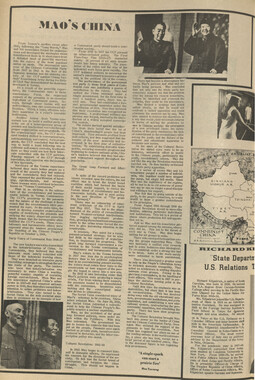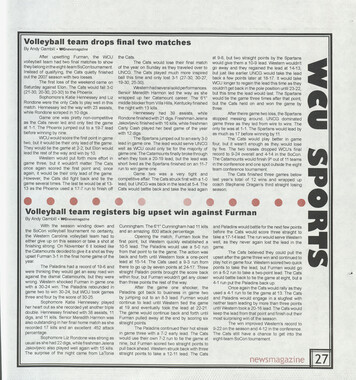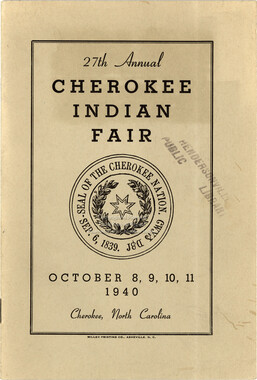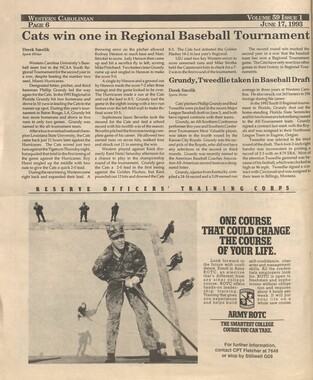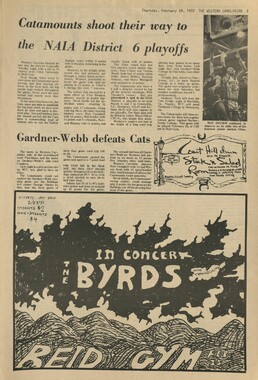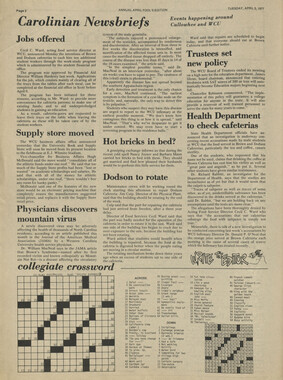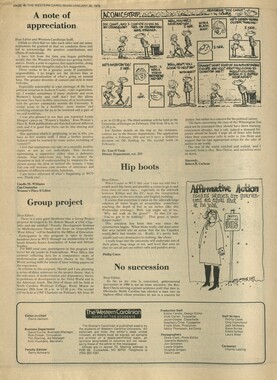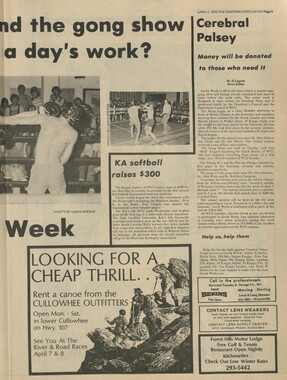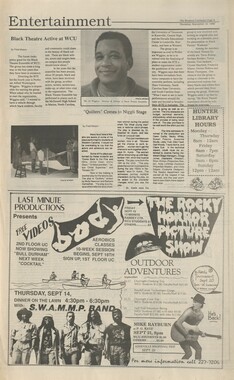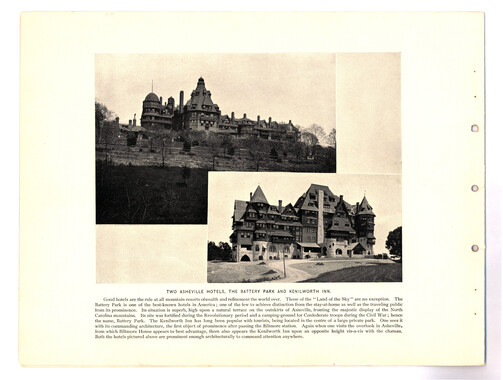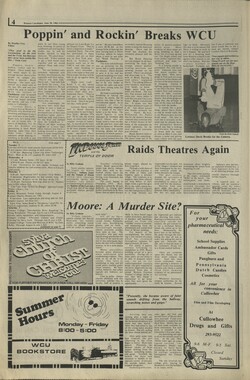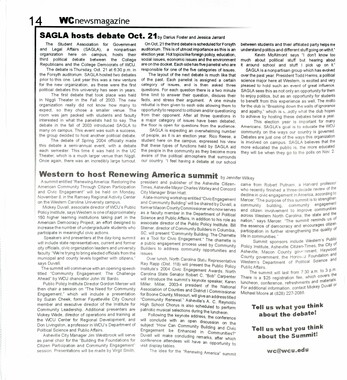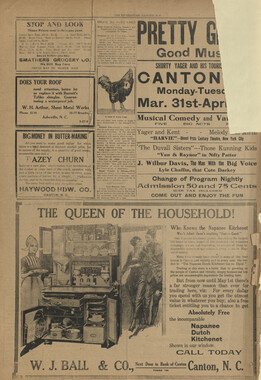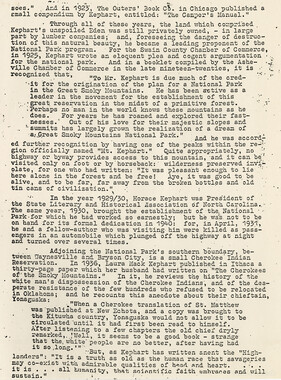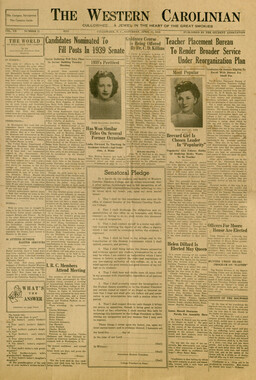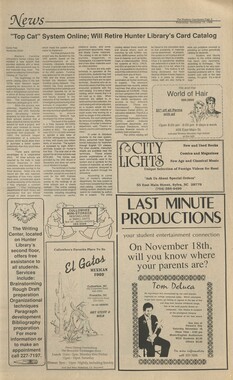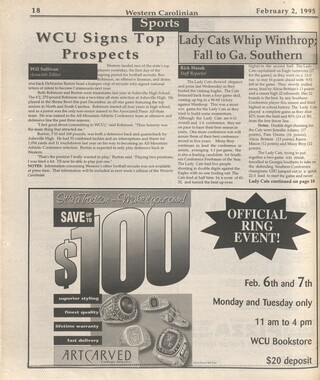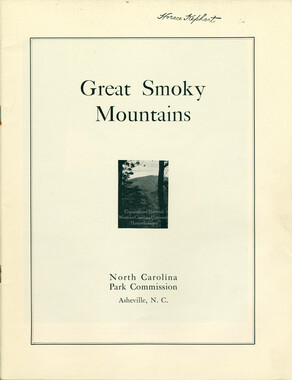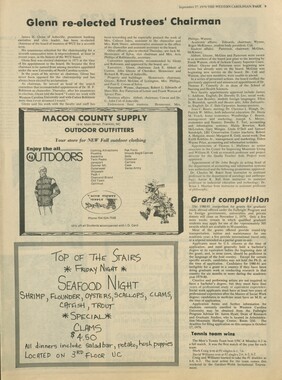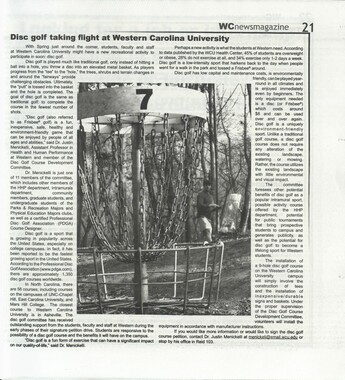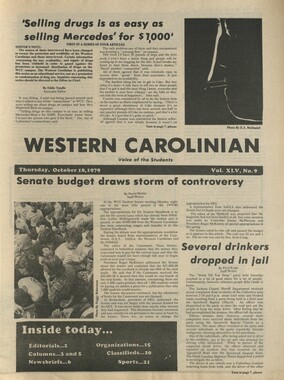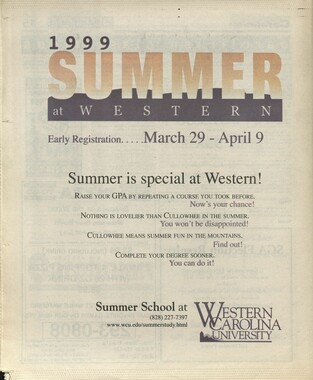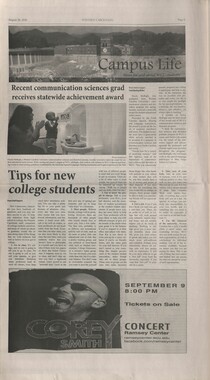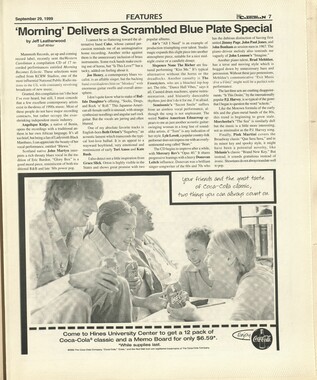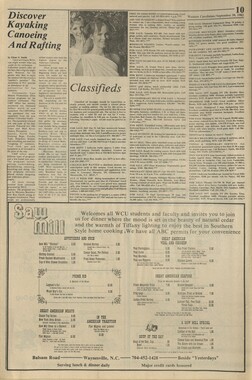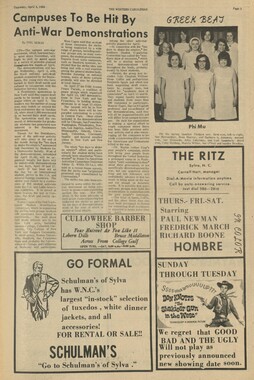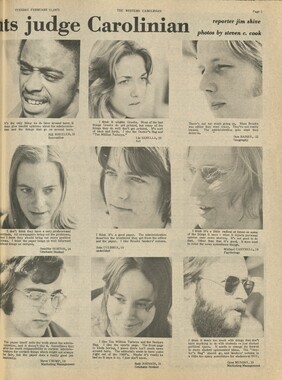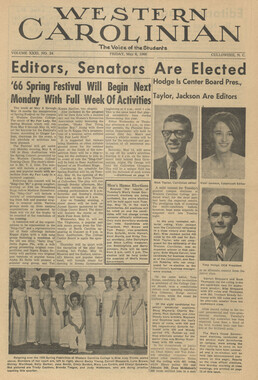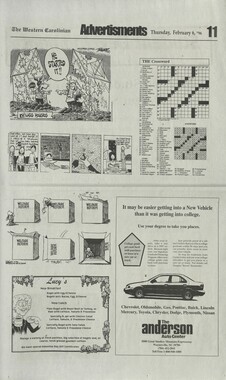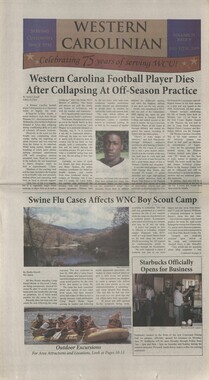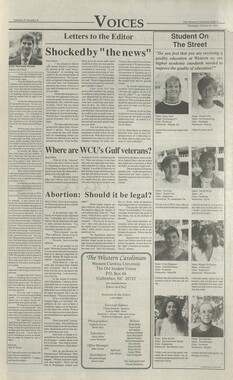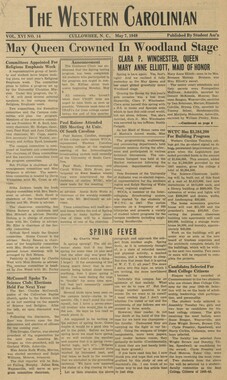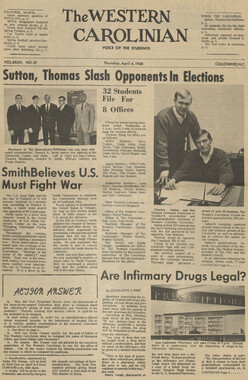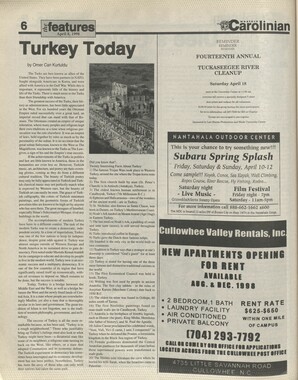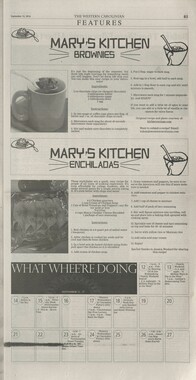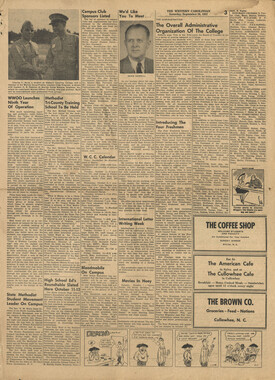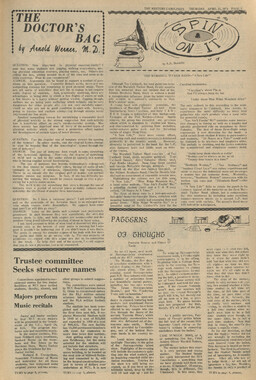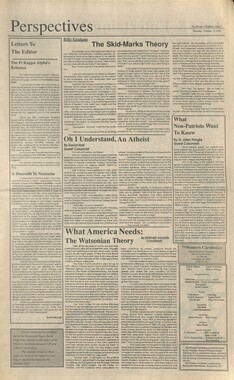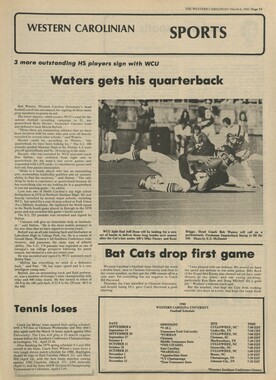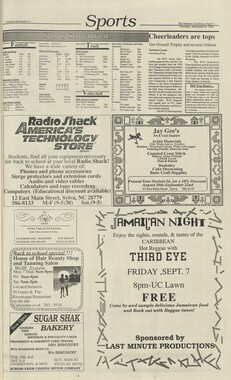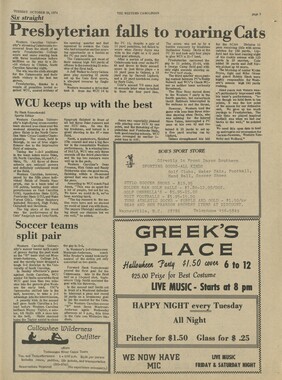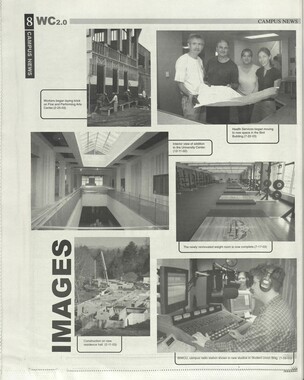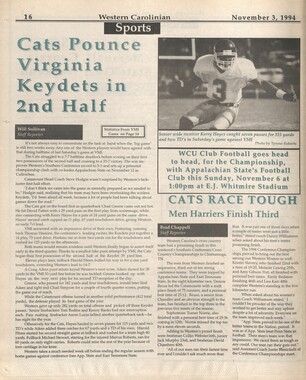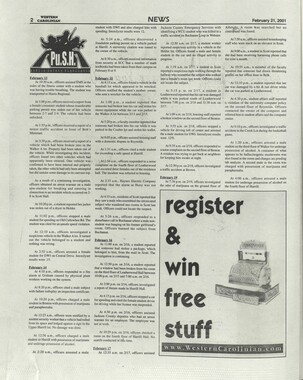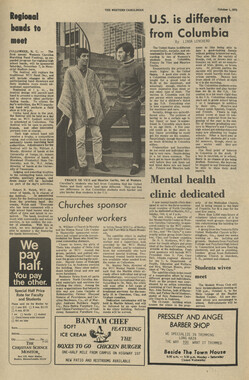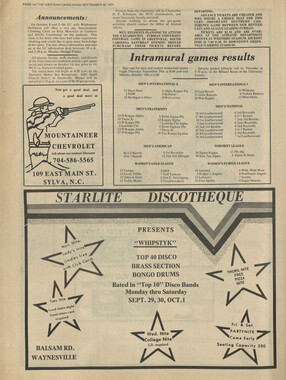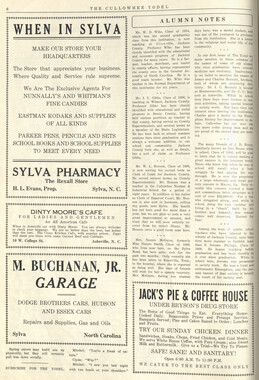Western Carolina University (21)
View all
- Canton Champion Fibre Company (2308)
- Cherokee Traditions (291)
- Civil War in Southern Appalachia (165)
- Craft Revival (1942)
- George Masa Collection (137)
- Great Smoky Mountains - A Park for America (2900)
- Highlights from Western Carolina University (422)
- Horace Kephart (941)
- Journeys Through Jackson (159)
- LGBTQIA+ Archive of Jackson County (85)
- Oral Histories of Western North Carolina (314)
- Picturing Appalachia (6797)
- Stories of Mountain Folk (413)
- Travel Western North Carolina (153)
- Western Carolina University Fine Art Museum Vitreograph Collection (129)
- Western Carolina University Herbarium (92)
- Western Carolina University: Making Memories (738)
- Western Carolina University Publications (2491)
- Western Carolina University Restricted Electronic Theses and Dissertations (146)
- Western North Carolina Regional Maps (71)
- World War II in Southern Appalachia (131)
University of North Carolina Asheville (6)
View all
- Allanstand Cottage Industries (62)
- Appalachian National Park Association (53)
- Bennett, Kelly, 1890-1974 (1463)
- Berry, Walter (76)
- Brasstown Carvers (40)
- Carver, George Washington, 1864?-1943 (26)
- Cathey, Joseph, 1803-1874 (1)
- Champion Fibre Company (233)
- Champion Paper and Fibre Company (297)
- Cherokee Indian Fair Association (16)
- Cherokee Language Program (22)
- Crowe, Amanda (40)
- Edmonston, Thomas Benton, 1842-1907 (7)
- Ensley, A. L. (Abraham Lincoln), 1865-1948 (275)
- Fromer, Irving Rhodes, 1913-1994 (70)
- George Butz (BFS 1907) (46)
- Goodrich, Frances Louisa (120)
- Grant, George Alexander, 1891-1964 (96)
- Heard, Marian Gladys (60)
- Kephart, Calvin, 1883-1969 (15)
- Kephart, Horace, 1862-1931 (313)
- Kephart, Laura, 1862-1954 (39)
- Laney, Gideon Thomas, 1889-1976 (439)
- Masa, George, 1881-1933 (61)
- McElhinney, William Julian, 1896-1953 (44)
- Niggli, Josephina, 1910-1983 (10)
- North Carolina Park Commission (105)
- Osborne, Kezia Stradley (9)
- Owens, Samuel Robert, 1918-1995 (11)
- Penland Weavers and Potters (36)
- Roberts, Vivienne (15)
- Roth, Albert, 1890-1974 (142)
- Schenck, Carl Alwin, 1868-1955 (1)
- Sherrill's Photography Studio (2565)
- Southern Highland Handicraft Guild (127)
- Southern Highlanders, Inc. (71)
- Stalcup, Jesse Bryson (46)
- Stearns, I. K. (213)
- Thompson, James Edward, 1880-1976 (226)
- United States. Indian Arts and Crafts Board (130)
- USFS (683)
- Vance, Zebulon Baird, 1830-1894 (1)
- Weaver, Zebulon, 1872-1948 (58)
- Western Carolina College (230)
- Western Carolina Teachers College (282)
- Western Carolina University (2008)
- Western Carolina University. Mountain Heritage Center (18)
- Whitman, Walt, 1819-1892 (10)
- Wilburn, Hiram Coleman, 1880-1967 (73)
- Williams, Isadora (3)
- Cain, Doreyl Ammons (0)
- Crittenden, Lorraine (0)
- Rhodes, Judy (0)
- Smith, Edward Clark (0)
- Appalachian Region, Southern (2929)
- Asheville (N.C.) (1944)
- Avery County (N.C.) (26)
- Blount County (Tenn.) (195)
- Buncombe County (N.C.) (1680)
- Cherokee County (N.C.) (283)
- Clay County (N.C.) (556)
- Graham County (N.C.) (238)
- Great Smoky Mountains National Park (N.C. and Tenn.) (525)
- Haywood County (N.C.) (3571)
- Henderson County (N.C.) (70)
- Jackson County (N.C.) (4917)
- Knox County (Tenn.) (35)
- Knoxville (Tenn.) (13)
- Lake Santeetlah (N.C.) (10)
- Macon County (N.C.) (420)
- Madison County (N.C.) (216)
- McDowell County (N.C.) (39)
- Mitchell County (N.C.) (135)
- Polk County (N.C.) (35)
- Qualla Boundary (982)
- Rutherford County (N.C.) (78)
- Swain County (N.C.) (2185)
- Transylvania County (N.C.) (270)
- Watauga County (N.C.) (12)
- Waynesville (N.C.) (86)
- Yancey County (N.C.) (72)
- Aerial Photographs (3)
- Aerial Views (60)
- Albums (books) (4)
- Articles (1)
- Artifacts (object Genre) (228)
- Bibliographies (1)
- Biography (general Genre) (2)
- Cards (information Artifacts) (38)
- Clippings (information Artifacts) (191)
- Copybooks (instructional Materials) (3)
- Crafts (art Genres) (622)
- Depictions (visual Works) (21)
- Design Drawings (1)
- Drawings (visual Works) (185)
- Envelopes (73)
- Exhibitions (events) (1)
- Facsimiles (reproductions) (1)
- Fiction (general Genre) (4)
- Financial Records (12)
- Fliers (printed Matter) (67)
- Glass Plate Negatives (381)
- Guidebooks (2)
- Internegatives (10)
- Interviews (815)
- Land Surveys (102)
- Letters (correspondence) (1013)
- Manuscripts (documents) (618)
- Maps (documents) (177)
- Memorandums (25)
- Minutes (administrative Records) (59)
- Negatives (photographs) (6090)
- Newsletters (1290)
- Newspapers (2)
- Notebooks (8)
- Occupation Currency (1)
- Paintings (visual Works) (1)
- Pen And Ink Drawings (1)
- Periodicals (193)
- Personal Narratives (10)
- Photographs (12976)
- Plans (maps) (1)
- Poetry (5)
- Portraits (4568)
- Postcards (329)
- Programs (documents) (181)
- Publications (documents) (2443)
- Questionnaires (65)
- Relief Prints (26)
- Sayings (literary Genre) (1)
- Scrapbooks (282)
- Sheet Music (2)
- Slides (photographs) (402)
- Songs (musical Compositions) (2)
- Sound Recordings (796)
- Specimens (92)
- Speeches (documents) (18)
- Tintypes (photographs) (8)
- Transcripts (322)
- Video Recordings (physical Artifacts) (23)
- Text Messages (0)
- A.L. Ensley Collection (275)
- Appalachian Industrial School Records (7)
- Appalachian National Park Association Records (336)
- Axley-Meroney Collection (2)
- Bayard Wootten Photograph Collection (20)
- Bethel Rural Community Organization Collection (7)
- Blumer Collection (5)
- C.W. Slagle Collection (20)
- Canton Area Historical Museum (2110)
- Carlos C. Campbell Collection (462)
- Cataloochee History Project (64)
- Cherokee Studies Collection (4)
- Daisy Dame Photograph Album (5)
- Daniel Boone VI Collection (1)
- Doris Ulmann Photograph Collection (112)
- Elizabeth H. Lasley Collection (1)
- Elizabeth Woolworth Szold Fleharty Collection (4)
- Frank Fry Collection (95)
- George Masa Collection (173)
- Gideon Laney Collection (452)
- Hazel Scarborough Collection (2)
- Hiram C. Wilburn Papers (28)
- Historic Photographs Collection (236)
- Horace Kephart Collection (861)
- Humbard Collection (33)
- Hunter and Weaver Families Collection (1)
- I. D. Blumenthal Collection (4)
- Isadora Williams Collection (4)
- Jesse Bryson Stalcup Collection (47)
- Jim Thompson Collection (224)
- John B. Battle Collection (7)
- John C. Campbell Folk School Records (80)
- John Parris Collection (6)
- Judaculla Rock project (2)
- Kelly Bennett Collection (1482)
- Love Family Papers (11)
- Major Wiley Parris Civil War Letters (3)
- Map Collection (12)
- McFee-Misemer Civil War Letters (34)
- Mountain Heritage Center Collection (4)
- Norburn - Robertson - Thomson Families Collection (44)
- Pauline Hood Collection (7)
- Pre-Guild Collection (2)
- Qualla Arts and Crafts Mutual Collection (12)
- R.A. Romanes Collection (681)
- Rosser H. Taylor Collection (1)
- Samuel Robert Owens Collection (94)
- Sara Madison Collection (144)
- Sherrill Studio Photo Collection (2558)
- Smoky Mountains Hiking Club Collection (616)
- Stories of Mountain Folk - Radio Programs (374)
- The Reporter, Western Carolina University (510)
- Venoy and Elizabeth Reed Collection (16)
- WCU Gender and Sexuality Oral History Project (32)
- WCU Mountain Heritage Center Oral Histories (25)
- WCU Oral History Collection - Mountain People, Mountain Lives (71)
- WCU Students Newspapers Collection (1923)
- Western North Carolina Tomorrow Black Oral History Project (69)
- William Williams Stringfield Collection (2)
- Zebulon Weaver Collection (109)
- African Americans (390)
- Appalachian Trail (35)
- Artisans (521)
- Cherokee art (84)
- Cherokee artists -- North Carolina (10)
- Cherokee language (21)
- Cherokee pottery (101)
- Cherokee women (208)
- Church buildings (190)
- Civilian Conservation Corps (U.S.) (111)
- College student newspapers and periodicals (2012)
- Dams (108)
- Dance (1023)
- Education (222)
- Floods (61)
- Folk music (1015)
- Forced removal, 1813-1903 (2)
- Forest conservation (220)
- Forests and forestry (1196)
- Gender nonconformity (4)
- Great Smoky Mountains National Park (N.C. and Tenn.) (181)
- Hunting (46)
- Landscape photography (25)
- Logging (119)
- Maps (83)
- Mines and mineral resources (9)
- North Carolina -- Maps (18)
- Paper industry (38)
- Postcards (255)
- Pottery (135)
- Railroad trains (72)
- Rural electrification -- North Carolina, Western (3)
- School integration -- Southern States (2)
- Segregation -- North Carolina, Western (5)
- Slavery (5)
- Sports (452)
- Storytelling (243)
- Waterfalls -- Great Smoky Mountains (N.C. and Tenn.) (66)
- Weaving -- Appalachian Region, Southern (280)
- Wood-carving -- Appalachian Region, Southern (328)
- World War, 1939-1945 (173)
Western Carolinian Volume 29 Number 18
Item
Item’s are ‘child’ level descriptions to ‘parent’ objects, (e.g. one page of a whole book).
-
-
Fashions For Coeds Innovations Seen In Loungeweare If any group of people has not been lying down on the job, it's the designers and makers of loungewear; their new ideas are helping women to relax in greater comfort and style than ever before. New styles like the jumper and poncho robe have joined the list of lounging classics. While the long hostess gown, more popular than ever, makes its sweeping fashion statement, this year's short robes — following the line of daytime fashion — just skim the knee. Fabrics and trimmings also show a rich variety. Quilting may appear In geometric patterns executed in the bold relief of Trnpunto. The trend to at-home elegance for the hostess shows up in robes of luxurious deep velvet and — shades of the glamorous Thirties! — lounging outfits trimmed in inarib^i'. Another current fashion trend lie sportive look, can be spotted in the boudoir as well as on the boulevard. In ei her place, wildlife prints ?re high style. Contributing to the lounger's life o) i a e tre the fabrics themselves. A popular choice among manufacturers of lounge-wear is a soft touch fabric which combines Eastman Kodel polyester, cotton and nylon for wrinkle- resistance and wearability. For added warmth and shape retention, many robes are also quilted wtih Kodel polyester fiberfill. Such new ideas are adding beauty and practicality to all types of loungewear. Altogether, the at-home outfits may be having their greatest fashion boom since the languid days of King Louis XVI's court, where it was considered chic to receive guests while lolling in bed! While you may not be prone to this type of self-indulgence, you can easily feel like a pampered princess in Lazy U's new knee-length robe of black or red velvet. Mandarin-collared and jewel-buttoned, it is quilted trapunto-fashion for a fresh elegant look. Somewhat more casual, though scarcely less elegant in its fashion, is Perfect Negligee's double-breasted, leopard - spotted coachman brunch coat. A warm but light-hearted new idea in lounging attire is a pull-over poncho to slip over a long-sleeved nightgown. Tempo makes a matching sleep shift in the same colors as the poncho. The easy-care fabric of Kodel, nylon and cotton is used for the gown and quilted with Kodel fiberfill for the poncho. But you can mix- match your own lounging outfits by teaming the poncho with other nightgowns in contrasting colors. These are just a few of the choices confronting the Easter < Has Conformity Become A "Thing Of The Past1 7 By Hines Hunt "The public arts have become private, and the private mysteries have become public — this is a paradox of our paradoxical age." This is the day of individualization and specialization. We have passed the day when conformity was the thing to do. Conformity was king in the days of the melting pot, when the open doors of unlimited immigration made all the new arrivals eager to melt into the "uniform grey pattern of American existence," and try earnestly to be or pretend to be like everybody else, in an age of standardization, and interchangeabil- ity of parts. However, this also makes conformity or nonconformity a paradox of the day, because today we are still conforming when we try to be different or individualistic because by trying to separate ourselves from a group, or society as a whole, whether in actions, ideas, thought, or innovations, we are still conforming to those who are like us — we have the common chracteristic of trying to be different. Music, art, and drama used to be shared experience in public, and could be seen and heard only in the company of others in concert halls, museums and theaters. Today these experiences tend more and more to be available chiefly in private — plays and films are looked at in the privacy of homes, as are paintings and prints through reproductions in books, and through pictures rented as library books once were. This is all a part of change and evolution. Communication media and the technological advances in communication have made for conformity and at the same time it has made for non-conformity. Everyone is striving to be different, everyone wants to get ahead, everyone is striving to be superior in his goals or in his career. Practically everyone is trying to break away from what used to be the ideal thing to do — to conform or to fit in, but now we want to stand out or to be different. However by trying to be different, we are actually conforming to an unorganized uniformity. Only recently an unoragnized group of young collegians at a state university said themselves to be against any form of organization — they thought each person should be individualistic in his ideas and actions. These students would meet and discuss this belief. No one was required to attend these meetings, the meetings were completely The quilted poncho for warm house wear. shopper, and the lucky lady who finds one among her packages on Christmas morning. Whatever your choice, you'll probably be leading a softer life — looking prettier, too — thanks to some inventive designers and manufacturers who have not been lying down on their fashion job. SCIENCE FACT & FABLE TODAY SCIENCE STILL, HASN'T ALL THE ANSWERS, BUT FOR,' GOOD ADVICE, GET SUFFICIENT REST, „ DRESS PROPERLY, AND TAKE DECONGESTANT COLD CAPSULES, SUCH AS CORYBAN-D, TO RELIEVE THE SYMPTOMS OF WINTERTIME MISERIES. DRINK PLENTY OF LIQUIDS, TOO. unorganized, very informal. Finally they decided to set a certain meeting time and a meeting place and later they elected officers. Their idea was to work to destroy all organizations. One day one of the members pointed out that they had organized themselves with the established meeting place and time and with the elected officers of the group. With nothing else to do, they immediately disestablished their organization because they had defeated the purpose of their idea — they had become organized, they had conformed to the conformity of uniformity. Today we are striving and tomorrow we will continue to strive to be different, but the only result will be conformity. FRIDAY, FEBRUARY 28, 1964 PAGE 5 WWOO To Offer Studies Of Chile Plans have been announced by Radio Station WWOO to broadcast IMAGE OF CHILE, a unique study-in-depth of Chilean culture as presented through its outstanding composers and musicians. The program, a release of The Intercollegiate Broadcasting system, will be featured at 7:00 P.M. on Monday nights and will consist of seven concerts. The series was made possible through the cooperation of the Embassy of Chile, the Pan American Union's Alliance for Progress Information Team in Washington, the IBS stations of American University in Washington, and Columbia University in New York, and the Voice of America. The IBS IMAGE OF CHILE series is, in a very real sense, a legacy of the late President Kennedy. When, on March 13, 1961, he proposed that the American Republics undertake the Alliance for Progress as a great cooperative effort in economic and social development in the Americas he emphasized that the program has a great cultural and spiritual aspect. The government of Chile was the first to respond to his invitation and the result was IMAGE OF CHILE, presented in Washington last fall and including seminars on literature, poetry, ri ama and exhibitions of graphic arts as well as music. this is the classic Maincoat you need IVORY, NAVY, OLIVE, BROWN, GRAY, and OYSTER $35.00 THE LONDON byionoon fog Precious few things are so right, so true, that they become classics. The London is one of them. One of the most popular Maincoots ever made, it owes its performance to superb Calibre Cloth (65% Dacron/35% Cotton), light and totally washable. Its looks are purely London Fog, smart and tailored-to-fit. In fashion, in quality, in perfect rain protection, there is no other to match The London. In the following colors: SCHULMAN'S "Style Center of Sylva"
Object
Object’s are ‘parent’ level descriptions to ‘children’ items, (e.g. a book with pages).
-
The Western Carolinian is Western Carolina University’s student-run newspaper. The paper was published as the Cullowhee Yodel from 1924 to 1931 before changing its name to The Western Carolinian in 1933.
-
